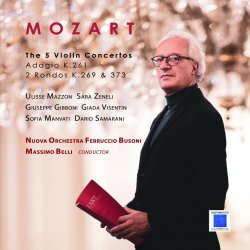
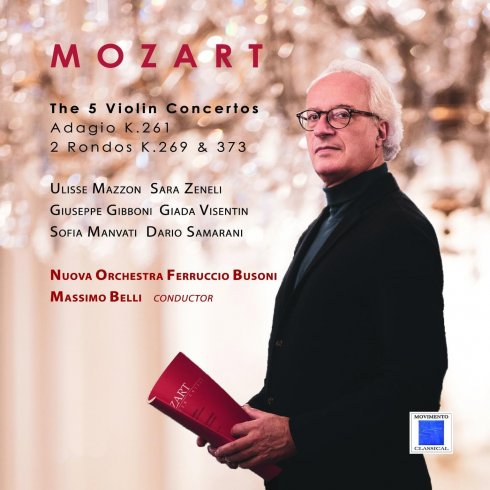
The 5 Violin Concertos
W.A. Mozart had as his first teacher his father Leopold, a famous violinist and author of a violin method published in 1756, Amadeus 's birth .
LittleMozart immediately showed that hehadwell learned the teachings of his father, who told of a first trip toVienna, in 1762,when Amadeus played fora customs officer in charge of border con- trols, leaving himastonished.
lt is likely that the violin had become for him the symbol of a "command" on the part of his father and this could explain why the production of works for violin and orchestra is much more limited than that for piano and orchestra.
Mozart composed over 20 concerts for piano and orchestra, while those for violin are just five (K 207, 211,216,218 and 219).
Violin concertos show an increasingly refined writing from time to time, especially from the third concert onwards, which is reflected in particular both on the shape and on the in strumentation . But from the first work we can find different characteristics common to the entire corpus of concerts , where in addition to liveliness and elegance we find a particular inspiration for the can- tabilità. These are brilliant concerts, with a living room and aristocratic atmosphere .
So drama and excessive tension cannot find space in it and give the scene to cheerful and joyful themes, but that shun any form of exaggeration .
Mozart therefore remains deeply faithful to neoclassica! aesthetics.
From a technical point of view, the author is inspired in particular by the great violin schools of the time,especially the ltalian oneofTartini andLocatelii.There arealsoseveraI elements of aBaroque character, such as the alternation between the orchestrai "all"and the solo passages, between the piano and the forte, as well as the copious presence of spring themes. The Allegro Moderato of Concerto K207 presents ali the main themes in the orchestrai exhibition and the live- liness ofthe initial theme is particularly evident.
In the following Adagio we then find a model of gallant style typical of eighteenth-century music, with a very clear reference to the sonata form. In fact, there are the typical formai elements of the latter, such as Exposure, Development, Shooting andTail.
The dialectic of the themes is obviously not Beethoven 's passionate and dramatic one, but takes piace as part of a continuous search for formai balance .
Very interesting is the Presto finale, where the main element becomes the pressing rhythm, fol- lowed by virtuosity of the soloist that, however, cannot be compared to those typical of the French school of Rode and Kreutzer .
This is because for Mozart the real skill of the soloist consisted not in the ability to dominate techni- cal difficulties, but in conquering a crystalline and timbre-rich sound. Exhibitionism was therefore set aside in favour of sound and timbre research.
The second Concerto K 211 was initially considered an "easy" ; concert , except then to make the musical critics believe, who almost immediately began to count it among the most diffi- cult for the soloist, engaged in passages that require great cantability especially in the acute regis- ter.
This is evident from the initial Allegro moderato, followed by an Andante with wide melodie lines. Finally, the opera ends with a final Rondò with a particularly elegant writing, which reaches even higher peaks in the third Concerto K216 and in the two subsequent concerts counterparts (K 218 and K 219).
For the first time, Allegro iniziale is characterized by a wide exhibition with countless thematic elements and a more articulated development, especially in the contrasts between different shades.
The Adagio is of intense and poignant singing, similar to an air of love, and the final Rondò appears as one of the most exuberant Mozart compositions . A dance in ternary time runs impetuously through the entire movement, sometimes with some variation .
Surprising and extravagant is the centrai part in minor ton ality : a melancholic Andante suddenly gives way to an Allegretto who recalls a folk dance .
The variety of themes, episodes and effects givesthe piece vivacity and imagination,which coexist happily thanks to a highly sought-after formai balance, which already portends the extraordinary artistic development of the Salzburg geniu s.
The Rondò k 373 in C major is a short composition lasting about six minutes, with a very refined style and even more intimate than violin concertos.
The theme is presented by the soloist and then taken up by the orchestra, alternating with episodes characterized by short tonai changes that contribute to creating a darker atmosphere full of pathos .
Significant in this sense is the episode in C minor, which preludes the final cadence and the tail, where the first violins dose the piece with anelegant gradient, similar to an echo.
The Rondò in Bflat major k 296 has a particular genesis, it was in fact written as an alternative to the finale of Concerto K 207.
The writing appears very simple compared to the classie form of Rondò, the theme of the violin is chamber music and always very refined.
The atmospheres are varied and iridescent and from bright they suddenly take on dramatic trait s. The last part of the song is surprising, when the violin and orchestra seem to begin the chorus, instead suddenly leaving room for the cadence of the soloist who ends in the authentic final chorus .


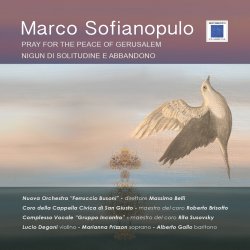
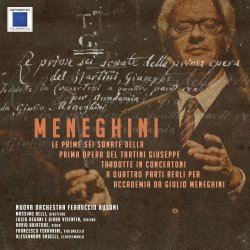
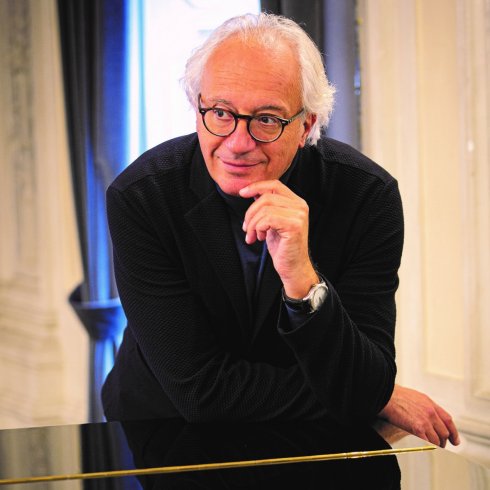
Massimo Belli
Began studying the violin with his father, then continued with Bruno Polli. Under the tutelage of Renato Zanettovich he graduated cum laude at the “B.Marcello” Conservatory of Venice. He followed specialization courses in Fiesole with the Trio di Trieste and Piero Farulli, and at the Accademia Chigiana di Siena with Henryk Szeryng. He was for two years a student of Salvatore Accardo’s at the Accademia di Alto Perfezionamento “W.Stauffer” in Cremona. The winner of numerous national and international competitions, he made his debut at sixteen at the Teatro Politeama Rossetti of Trieste for the Concert Society; later, as a soloist, he performed in Europe, the ex-Soviet Union, Turkey and South America. He has performed the principal concertos in the violin repertoire, accompanied by such notable orchestras and he was lead violinist in the Italian Youth Orchestra, the Busoni Orchestra, the Haydn Philharmonia, and both lead violinist and conductor of the Virtuosi dell’Ensemble di Venezia. The great Triestine composer Giulio Viozzi dedicated to Massimo Belli a piece for solo violin, “Tema variato”, published by Pizzicato. He has broadcast on radio and television in Italy, the Soviet Union, Germany, Yugoslavia, Brazil, and Austria, and has recorded for Sipario Dischi, for Nuova Era and he currently records for Concerto Classics, Warner Classics, Brilliant Classics and Movimento Classical. He studied conducting with Aldo Belli and Julian Kovatchev, and is the conductor of the New “Ferruccio Busoni” Chamber Orchestra. He teaches violin at the Trieste Conservatory. He has taught at the United World College of the Adriatic, at the summer courses in Solighetto, and was invited to give Masterclasses at the Conservatorio Reale di Murcia (Spain), the Hoochschule of Mannheim and the Academy of Tallin and Belarusian State Academy of Musik di Minsk. He is also a teacher at the International Music Masterclasses of Cividale.He was for five years Vice-Director of the “Giuseppe Tartini” Conservatory of Trieste and was on the Administrative Council of Trieste’s “Giuseppe Verdi” Opera House Foundation.He recently conducted I Cameristi del Maggio Fiorentino and Euro Sinfonietta Wien.
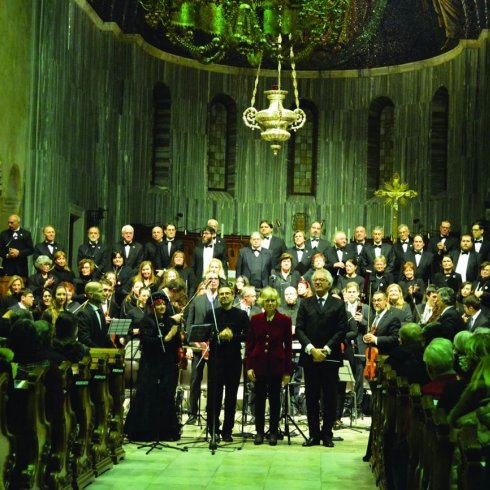
The “Ferruccio Busoni” Chamber Orchestra
The “Ferruccio Busoni” Chamber Orchestra, a well-known ensemble founded in 1965 by Aldo Belli, is one of the first chamber orchestras to appear in Italy during the post-war period. It is also the oldest in the Region of Friuli Venezia Giulia, and in 2008 was recognized by the Region as an “institution of regional importance”. It is made up of established instrumentalists, winners of important international competitions, who can boast extensive concert experience as both soloists and members of chamber groups, passing on the musical culture of the Trio di Trieste and the Quartetto Italiano whose pupils they were. In 2005 and 2010 the orchestra celebrated its 40th and 45th anniversaries with concerts featuring the special appearance of the violinist Salvatore Accardo, the concerts met with great popular and critical acclaim. The concert celebrating its 50th anniversary, held in collaboration with Trieste’s Teatro Verdi, had as its guest the violinist Domenico Nordio, and was highly successful. The “live” recording of it was published by the Amadeus review in December 2015.For the 50th anniversary the Friuli Venezia Giulia Region published a book on the Busoni Orchestra, as part of the Region’s promotion of its image at an international level.The orchestra has caught the attention of public and critics alike by its performances in Austria, Slovenia, Croatia, Germany, Switzerland, Tunisia, Russia and Italy, with excellent soloists.On October 30th, 2013 the Busoni Orchestra, as Italy’s representative, gave the opening concert in the International Silver Lyre Festival, organized by the Philharmonic Society of St. Petersburg, enjoying a great success with the audience.Ever ready to promote contemporary music, the orchestra has to its credit the premiere performances of a good number of works – some of which are dedicated to the Busoni Orchestra – by such contemporary composers as Nieder, Sofianopulo, Margola, Conti, Viozzi, Coral, Dott, Visnoviz, Bellini, Glass and the premiere performances in modern time by such composers as Giuseppe Tartini, Wolfgang Amadeus Mozart, Andrea Luchesi e Alessandro Rolla.The Busoni orchestra is the creator and principal performer in the Mattinate Musicali at Trieste’s Museo Revoltella, a celebration of chamber music which has now been active for nineteen years.The ensemble has recorded 20 CD for the record company Velut Luna, Concerto Classics, Brilliant Classics, Warner Classics e Amadeus which have received prestigious recognition.Since 2013 the Busoni orchestra has been involved in a project to rediscover the music of the Veneto composer Andrea Luchesi; so far the Milan record company “Concerto Classics” has published five world premiere CDs dedicated to his music, recorded by the Busoni orchestra. The Busoni orchestra has recorded for Italian Radio and Television (RAI), for SKY Classic and for Canale 5.In March 2018 the review Amadeus published the CD including world premiere recordings of the two Concerti of Giuseppe Tartini with the violinist Laura Marzadori. In May 2019 the record company Brilliant Classics published the CD with music by Ermanno Wolf Ferrari recorded with Fabien Thouand e Valentino Zucchiatti. In January 2020 Movimento Classical first published the complete version of Giulio Meneghini's Concertoni.
